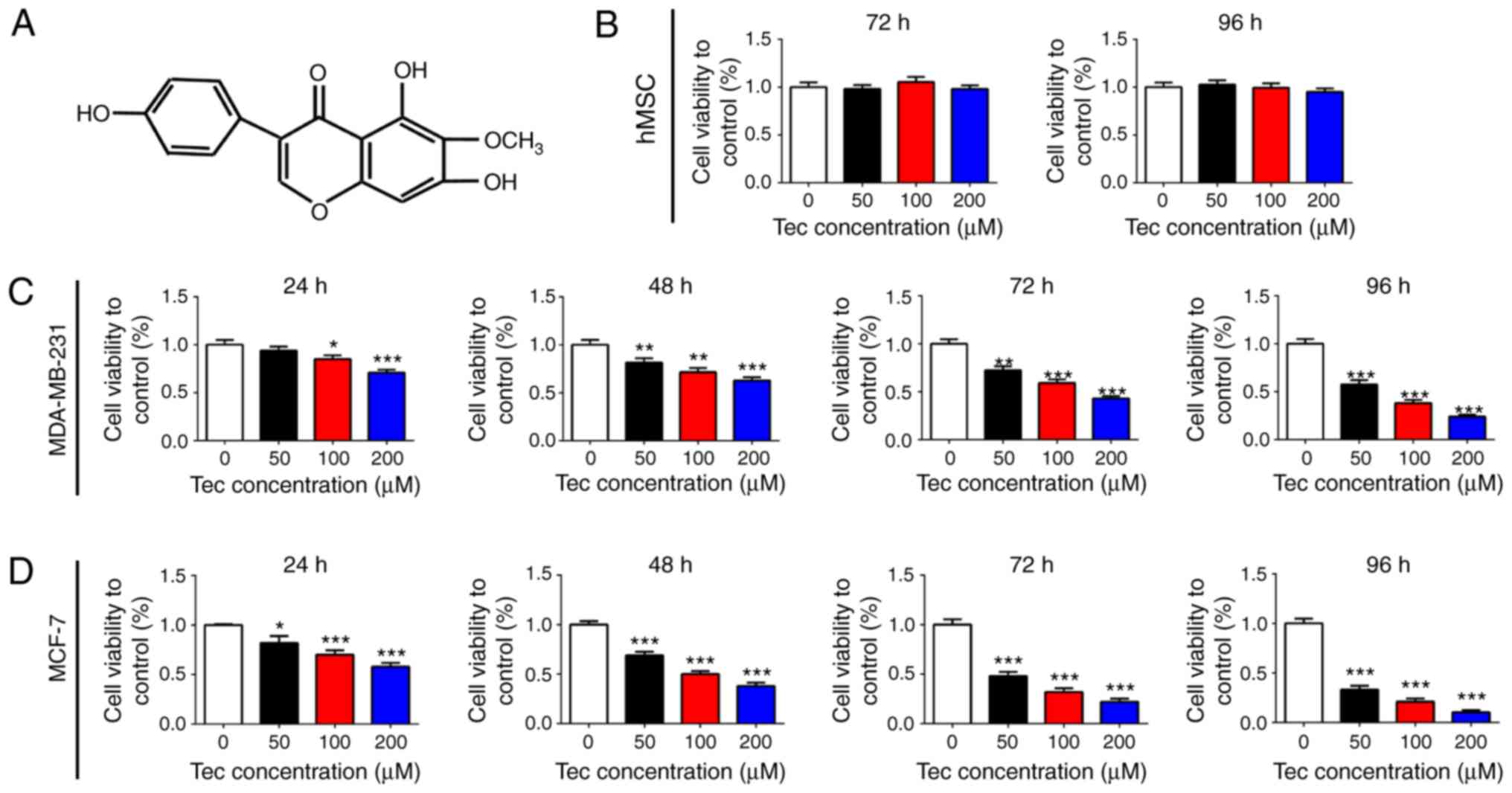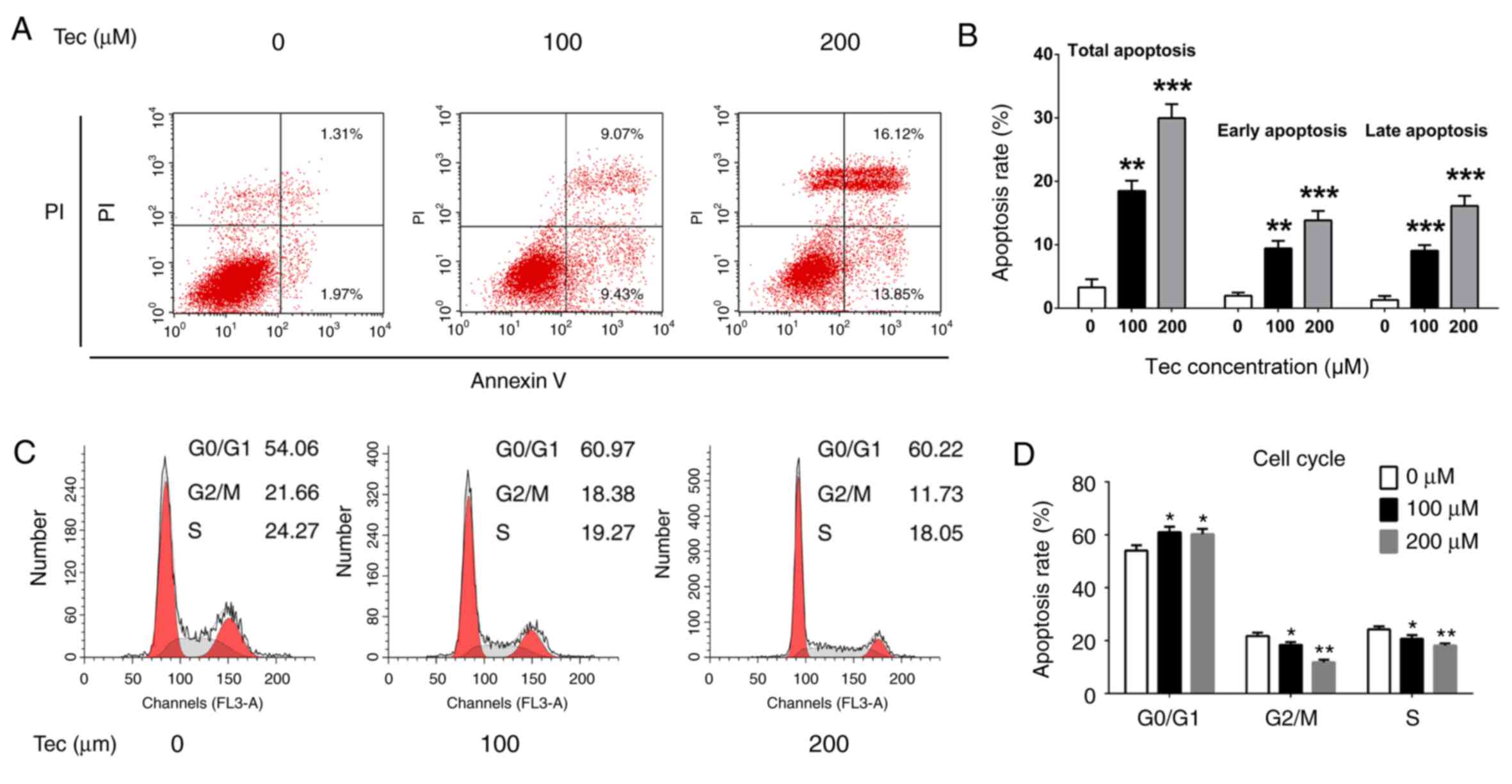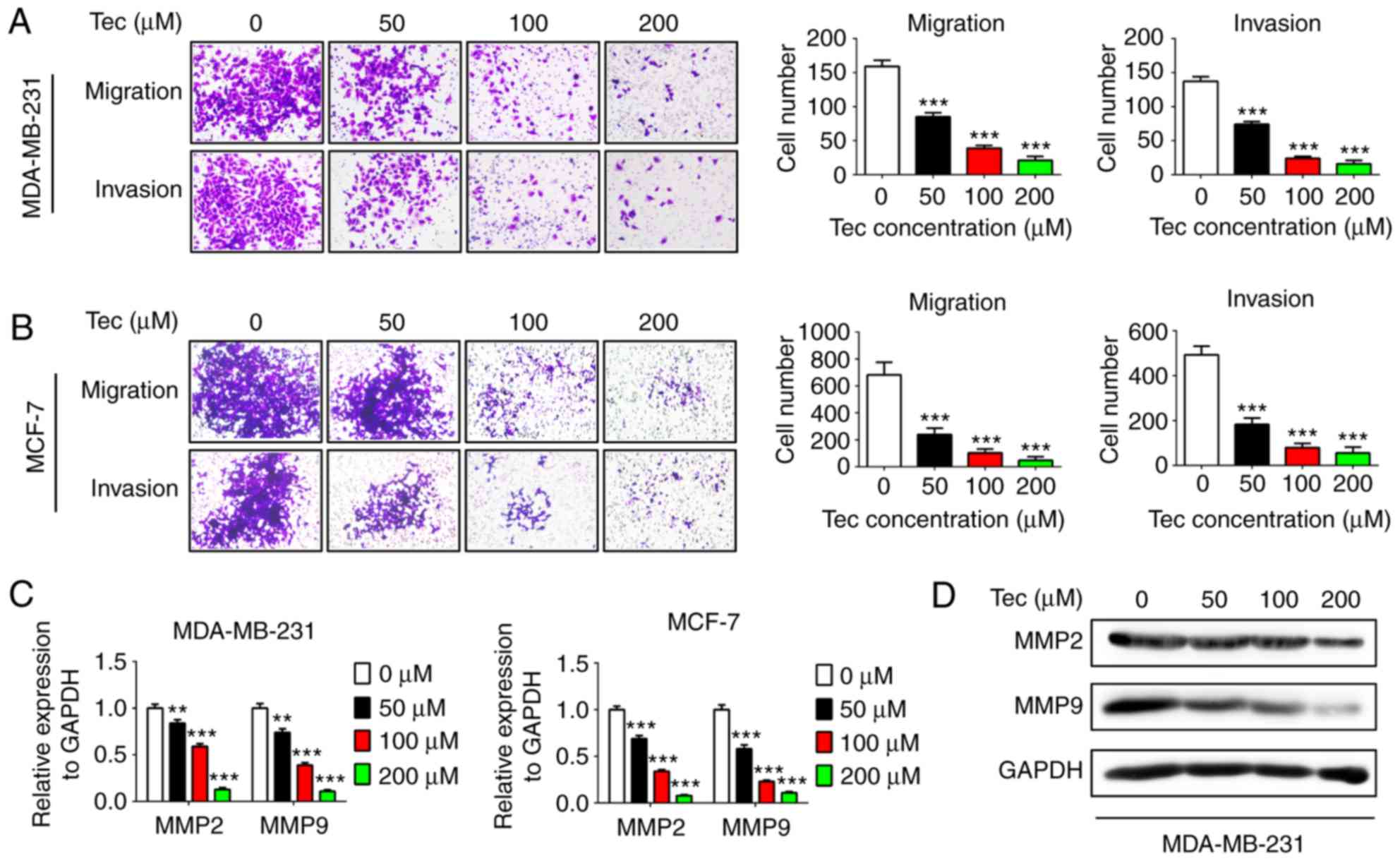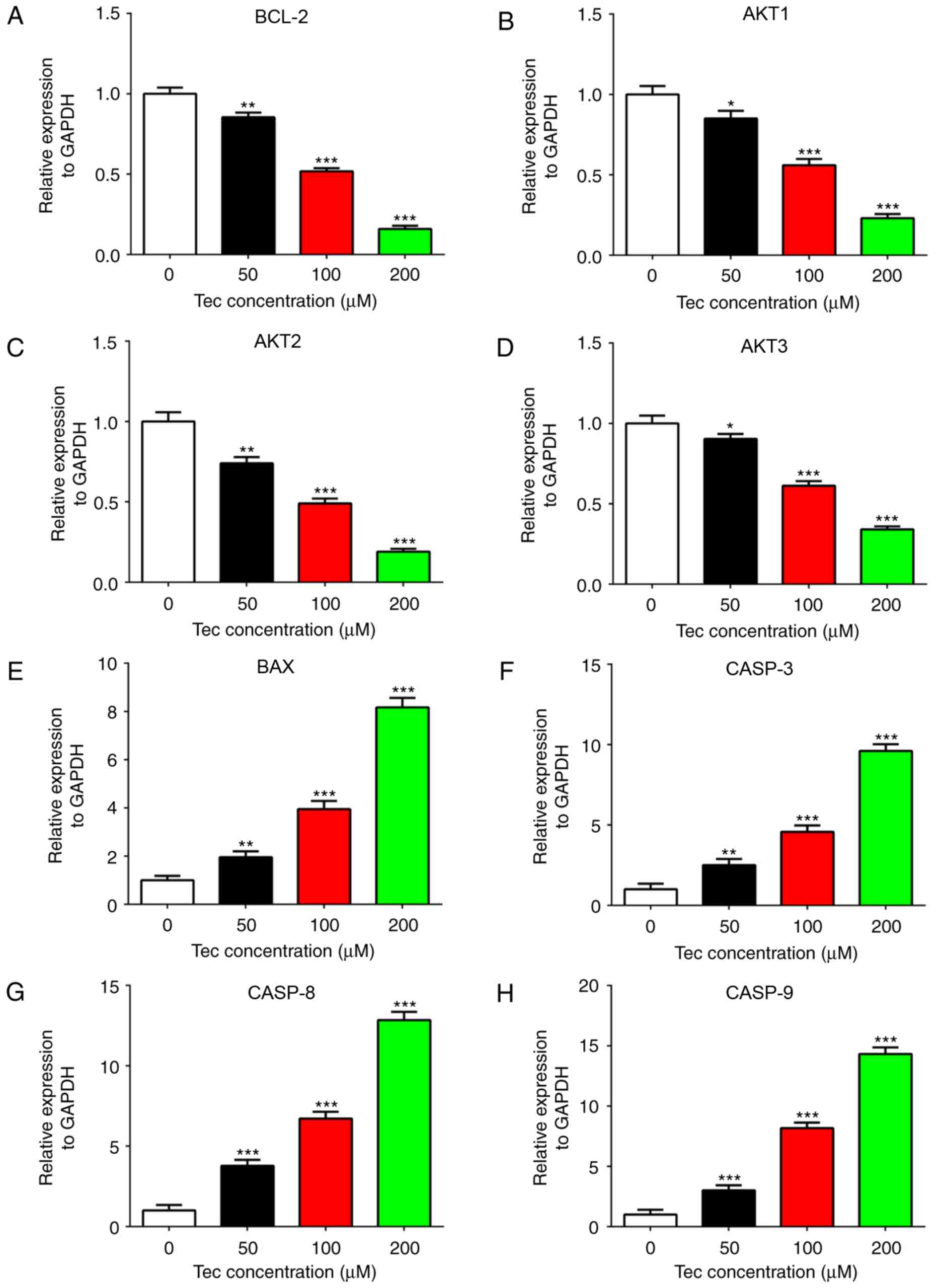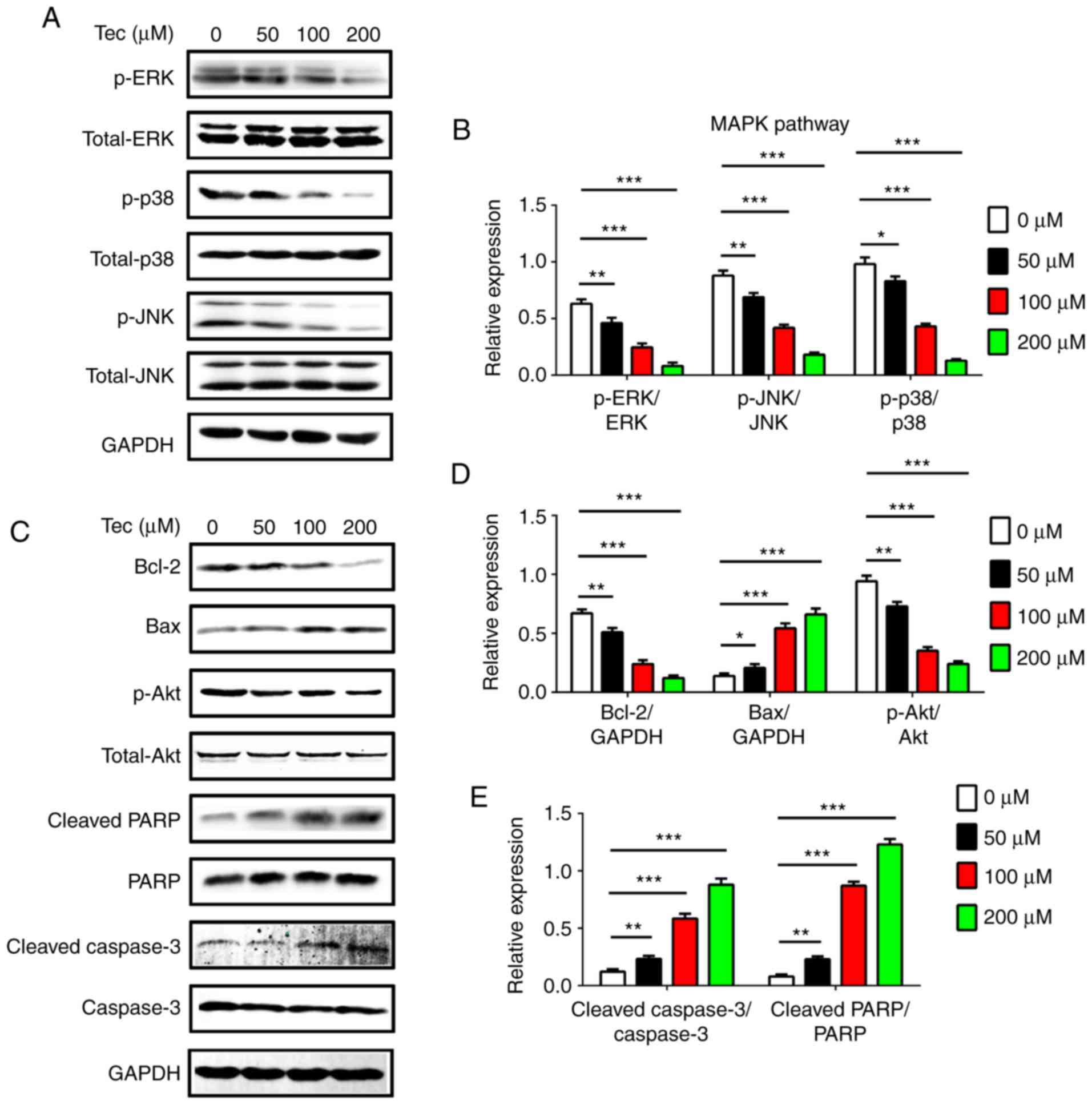|
1
|
Kwak JH, Park JY, Lee D, Kwak JY, Park EH,
Kim KH, Park HJ, Kim HY, Jang HJ, Ham J, et al: Inhibitory effects
of ginseng sapogenins on the proliferation of triple negative
breast cancer MDA-MB-231 cells. Bioorg Med Chem Lett. 24:5409–5412.
2014. View Article : Google Scholar : PubMed/NCBI
|
|
2
|
Wang P, Du X, Xiong M, Cui J, Yang Q, Wang
W, Chen Y and Zhang T: Ginsenoside Rd attenuates breast cancer
metastasis implicating derepressing microRNA-18a-regulated Smad2
expression. Sci Rep. 6:337092016. View Article : Google Scholar : PubMed/NCBI
|
|
3
|
Jia Y, Wang X, Liu Q, Leung AW, Wang P and
Xu C: Sonodynamic action of hypocrellin B triggers cell apoptosis
of breast cancer cells involving caspase pathway. Ultrasonics.
73:154–161. 2017. View Article : Google Scholar : PubMed/NCBI
|
|
4
|
Qiao H, Wang TY, Yan W, Qin A, Fan QM, Han
XG, Wang YG and Tang TT: Synergistic suppression of human breast
cancer cells by combination of plumbagin and zoledronic acid in
vitro. Acta Pharmacol Sin. 36:1085–1098. 2015. View Article : Google Scholar : PubMed/NCBI
|
|
5
|
He J, Du L, Bao M, Zhang B, Qian H, Zhou Q
and Cao Z: Oroxin A inhibits breast cancer cell growth by inducing
robust endoplasmic reticulum stress and senescence. Anti-cancer
Drugs. 27:204–215. 2016. View Article : Google Scholar : PubMed/NCBI
|
|
6
|
Liedtke C, Mazouni C, Hess KR, André F,
Tordai A, Mejia JA, Symmans WF, Gonzalez-Angulo AM, Hennessy B,
Green M, et al: Response to neoadjuvant therapy and long-term
survival in patients with triple-negative breast cancer. J Clin
Oncol. 26:1275–1281. 2008. View Article : Google Scholar : PubMed/NCBI
|
|
7
|
Qu Z, Cui J, Harata-Lee Y, Aung TN, Feng
Q, Raison JM, Kortschak RD and Adelson DL: Identification of
candidate anti-cancer molecular mechanisms of compound kushen
injection using functional genomics. Oncotarget. 7:66003–66019.
2016. View Article : Google Scholar : PubMed/NCBI
|
|
8
|
Zhang Y, He L, Yue S, Huang Q, Zhang Y and
Yang J: Characterization and evaluation of a self-microemulsifying
drug delivery system containing tectorigenin, an isoflavone with
low aqueous solubility and poor permeability. Drug Deliv.
24:632–640. 2017. View Article : Google Scholar : PubMed/NCBI
|
|
9
|
Guo Y, Chen YH, Cheng ZH, Ou-Yang HN, Luo
C and Guo ZL: Tectorigenin inhibits osteosarcoma cell migration
through downregulation of matrix metalloproteinases in vitro.
Anticancer Drugs. 27:540–546. 2016. View Article : Google Scholar : PubMed/NCBI
|
|
10
|
Yang YI, Lee KT, Park HJ, Kim TJ, Choi YS,
Shih Ie M and Choi JH: Tectorigenin sensitizes paclitaxel-resistant
human ovarian cancer cells through downregulation of the Akt and
NFκB pathway. Carcinogenesis. 33:2488–2498. 2012. View Article : Google Scholar : PubMed/NCBI
|
|
11
|
Amin A, Mokhdomi TA, Bukhari S, Wani SH,
Wafai AH, Lone GN, Qadri A and Qadri RA: Tectorigenin ablates the
inflammation-induced epithelial-mesenchymal transition in a
co-culture model of human lung carcinoma. Pharmacol Rep.
67:382–387. 2015. View Article : Google Scholar : PubMed/NCBI
|
|
12
|
Jiang CP, Ding H, Shi DH, Wang YR, Li EG
and Wu JH: Pro-apoptotic effects of tectorigenin on human
hepatocellular carcinoma HepG2 cells. World J Gastroenterol.
18:1753–1764. 2012. View Article : Google Scholar : PubMed/NCBI
|
|
13
|
Lee KT, Sohn IC, Kim YK, Choi JH, Choi JW,
Park HJ, Itoh Y and Miyamoto K: Tectorigenin, an isoflavone of
Pueraria thunbergiana Benth., induces differentiation and apoptosis
in human promyelocytic leukemia HL-60 cells. Biol Pharm Bull.
24:1117–1121. 2001. View Article : Google Scholar : PubMed/NCBI
|
|
14
|
Li QY, Chen L, Yan MM, Shi XJ and Zhong
MK: Tectorigenin regulates adipogenic differentiation and
adipocytokines secretion via PPARγ and IKK/NF-κB signaling. Pharm
Biol. 53:1567–1575. 2015. View Article : Google Scholar : PubMed/NCBI
|
|
15
|
Monthakantirat O, De-Eknamkul W, Umehara
K, Yoshinaga Y, Miyase T, Warashina T and Noguchi H: Phenolic
constituents of the rhizomes of the Thai medicinal plant Belamcanda
chinensis with proliferative activity for two breast cancer cell
lines. J Nat Prod. 68:361–364. 2005. View Article : Google Scholar : PubMed/NCBI
|
|
16
|
Umehara K, Nemoto K, Matsushita A, Terada
E, Monthakantirat O, De-Eknamkul W, Miyase T, Warashina T, Degawa M
and Noguchi H: Flavonoids from the heartwood of the Thai medicinal
plant Dalbergia parviflora and their effects on
estrogenic-responsive human breast cancer cells. J Nat Prod.
72:2163–2168. 2009. View Article : Google Scholar : PubMed/NCBI
|
|
17
|
Han XG, Li Y, Mo HM, Li K, Lin D, Zhao CQ,
Zhao J and Tang TT: TIMP3 regulates osteosarcoma cell migration,
invasion and chemotherapeutic resistances. Tumour Biol.
37:8857–8867. 2016. View Article : Google Scholar : PubMed/NCBI
|
|
18
|
Livak KJ and Schmittgen TD: Analysis of
relative gene expression data using real-time quantitative PCR and
the 2(-Delta Delta C(T) method. Methods. 25:402–408. 2001.
View Article : Google Scholar : PubMed/NCBI
|
|
19
|
Fang C, Wang FB, Li Y and Zeng XT:
Down-regulation of miR-199b-5p is correlated with poor prognosis
for breast cancer patients. Biomed Pharmacother. 84:1189–1193.
2016. View Article : Google Scholar : PubMed/NCBI
|
|
20
|
Chlebowski RT, Pan K and Col NF: Ovarian
suppression in combination endocrine adjuvant therapy in
premenopausal women with early breast cancer. Breast Cancer Res
Treat. 161:185–190. 2017. View Article : Google Scholar : PubMed/NCBI
|
|
21
|
Kong X, Li Z and Li X: GSTP1, GSTM1 and
GSTT1 polymorphisms as predictors of response to chemotherapy in
patients with breast cancer: A meta-analysis. Cancer Chemother
Pharmacol. 78:1163–1173. 2016. View Article : Google Scholar : PubMed/NCBI
|
|
22
|
Sun S, Wang F, Dou H, Zhang L and Li J:
Preventive effect of zoledronic acid on aromatase
inhibitor-associated bone loss for postmenopausal breast cancer
patients receiving adjuvant letrozole. Onco Targets Ther.
9:6029–6036. 2016. View Article : Google Scholar : PubMed/NCBI
|
|
23
|
Meng L, Xu Y, Xu C and Zhang W: Biomarker
discovery to improve prediction of breast cancer survival: Using
gene expression profiling, meta-analysis and tissue validation.
Onco Targets Ther. 9:6177–6185. 2016. View Article : Google Scholar : PubMed/NCBI
|
|
24
|
Fleisher B, Clarke C and Ait-Oudhia S:
Current advances in biomarkers for targeted therapy in
triple-negative breast cancer. Breast Cancer (Dove Med Press).
8:183–197. 2016.PubMed/NCBI
|
|
25
|
Wang X, Xia X, Leung AW, Xiang J, Jiang Y,
Wang P, Xu J, Yu H, Bai D and Xu C: Ultrasound induces cellular
destruction of nasopharyngeal carcinoma cells in the presence of
curcumin. Ultrasonics. 51:165–170. 2011. View Article : Google Scholar : PubMed/NCBI
|
|
26
|
Tan XL, Guo L and Wang GH: Polyporus
umbellatus inhibited tumor cell proliferation and promoted tumor
cell apoptosis by down-regulating AKT in breast cancer. Biomed
Pharmacother. 83:526–535. 2016. View Article : Google Scholar : PubMed/NCBI
|
|
27
|
Iwanowycz S, Wang J, Hodge J, Wang Y, Yu F
and Fan D: Emodin inhibits breast cancer growth by blocking the
tumor-promoting feedforward loop between cancer cells and
macrophages. Mol Cancer Ther. 15:1931–1942. 2016. View Article : Google Scholar : PubMed/NCBI
|
|
28
|
Kapoor S: Tectorigenin and its inhibitory
effects on tumor growth in systemic malignancies. Immunopharmacol
Immunotoxicol. 35:5332013. View Article : Google Scholar : PubMed/NCBI
|
|
29
|
Ha le M, Que do TN, Huyen do TT, Long PQ
and Dat NT: Toxicity, analgesic and anti-inflammatory activities of
tectorigenin. Immunopharmacol Immunotoxicol. 35:336–340. 2013.
View Article : Google Scholar : PubMed/NCBI
|
|
30
|
Thelen P, Scharf JG, Burfeind P,
Hemmerlein B, Wuttke W, Spengler B, Christoffel V, Ringert RH and
Seidlová-Wuttke D: Tectorigenin and other phytochemicals extracted
from leopard lily Belamcanda chinensis affect new and established
targets for therapies in prostate cancer. Carcinogenesis.
26:1360–1367. 2005. View Article : Google Scholar : PubMed/NCBI
|
|
31
|
Ho JY, Hsu RJ, Liu JM, Chen SC, Liao GS,
Gao HW and Yu CP: MicroRNA-382-5p aggravates breast cancer
progression by regulating the RERG/Ras/ERK signaling axis.
Oncotarget. 8:22443–22459. 2017. View Article : Google Scholar : PubMed/NCBI
|
|
32
|
Wang D, Wu P, Wang H, Zhu L, Zhao W and Lu
Y: SIN1 promotes the proliferation and migration of breast cancer
cells by Akt activation. Biosci Rep. 36:e004242016. View Article : Google Scholar : PubMed/NCBI
|
|
33
|
Wang H, Jia XH, Chen JR, Yi YJ, Wang JY,
Li YJ and Xie SY: HOXB4 knockdown reverses multidrug resistance of
human myelogenous leukemia K562/ADM cells by downregulating P-gp,
MRP1 and BCRP expression via PI3K/Akt signaling pathway. Int J
Oncol. 49:2529–2537. 2016. View Article : Google Scholar : PubMed/NCBI
|
|
34
|
Aghazadeh S and Yazdanparast R:
Mycophenolic acid potentiates HER2-overexpressing SKBR3 breast
cancer cell line to induce apoptosis: Involvement of AKT/FOXO1 and
JAK2/STAT3 pathways. Apoptosis. 21:1302–1314. 2016. View Article : Google Scholar : PubMed/NCBI
|
|
35
|
Zhang Z, Liu L, Liu C, Cao S, Zhu Y and
Mei Q: TIPE2 suppresses the tumorigenesis, growth and metastasis of
breast cancer via inhibition of the AKT and p38 signaling pathways.
Oncol Rep. 36:3311–3316. 2016. View Article : Google Scholar : PubMed/NCBI
|
|
36
|
Din TA, Seeni A, Yusoff MS, Shamsuddin S
and Jaafar H: PF4-Induced apoptosis in breast cancer in vivo study:
The role of the caspases family. Pathology. 48 Suppl 1:S1222016.
View Article : Google Scholar
|
|
37
|
Lazebnik YA, Kaufmann SH, Desnoyers S,
Poirier GG and Earnshaw WC: Cleavage of poly(ADP-ribose) polymerase
by a proteinase with properties like ICE. Nature. 371:346–347.
1994. View Article : Google Scholar : PubMed/NCBI
|
|
38
|
Soldani C and Scovassi AI:
Poly(ADP-ribose) polymerase-1 cleavage during apoptosis: An update.
Apoptosis. 7:321–328. 2002. View Article : Google Scholar : PubMed/NCBI
|
|
39
|
Bhaskara VK, Panigrahi M, Challa S and
Babu PP: Comparative status of activated ERK1/2 and PARP cleavage
in human gliomas. Neuropathology. 25:48–53. 2005. View Article : Google Scholar : PubMed/NCBI
|
|
40
|
Sharifi S, Barar J, Hejazi MS and Samadi
N: Roles of the Bcl-2/Bax ratio, caspase-8 and 9 in resistance of
breast cancer cells to paclitaxel. Asian Pac J Cancer Prev.
15:8617–8622. 2014. View Article : Google Scholar : PubMed/NCBI
|



